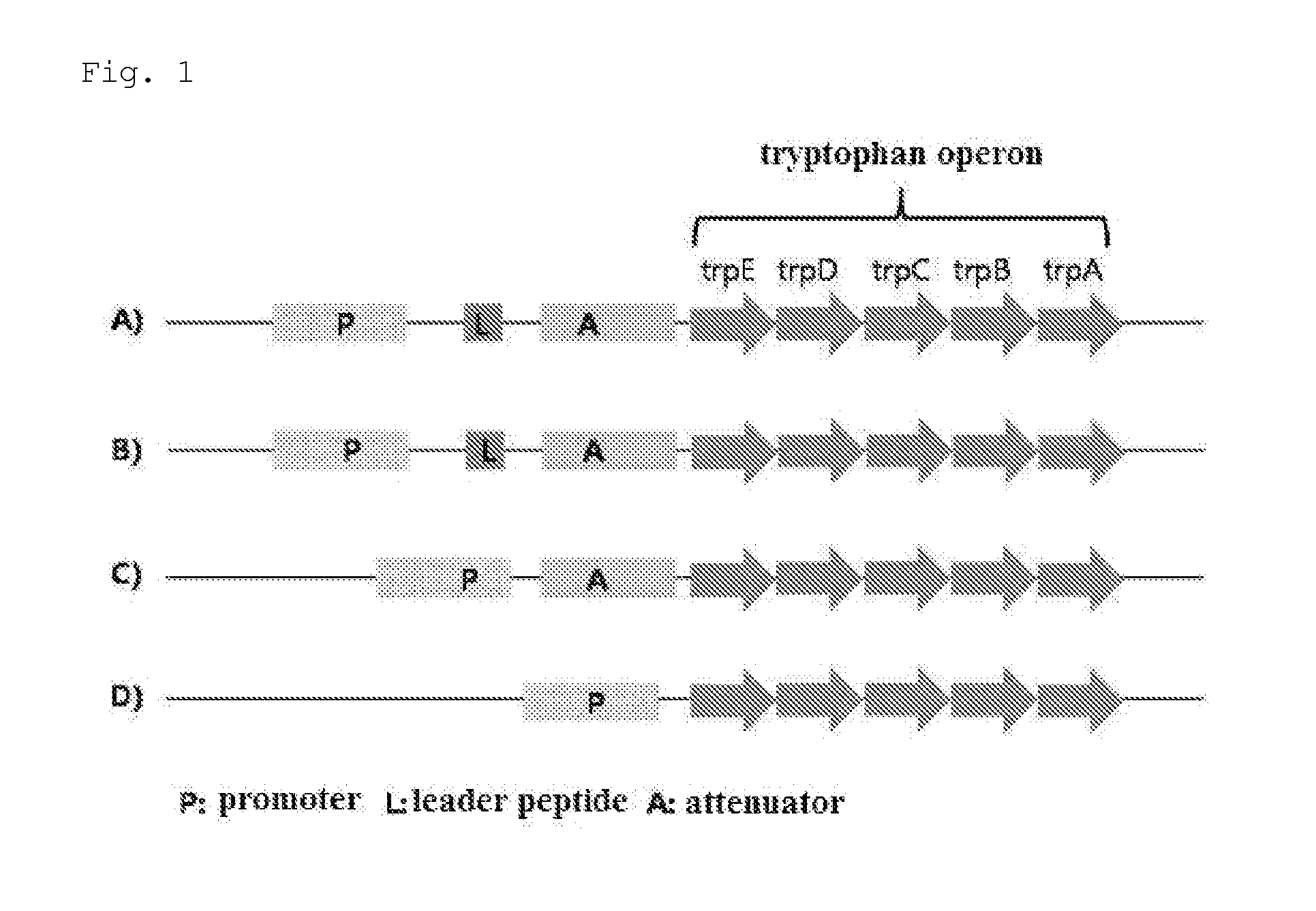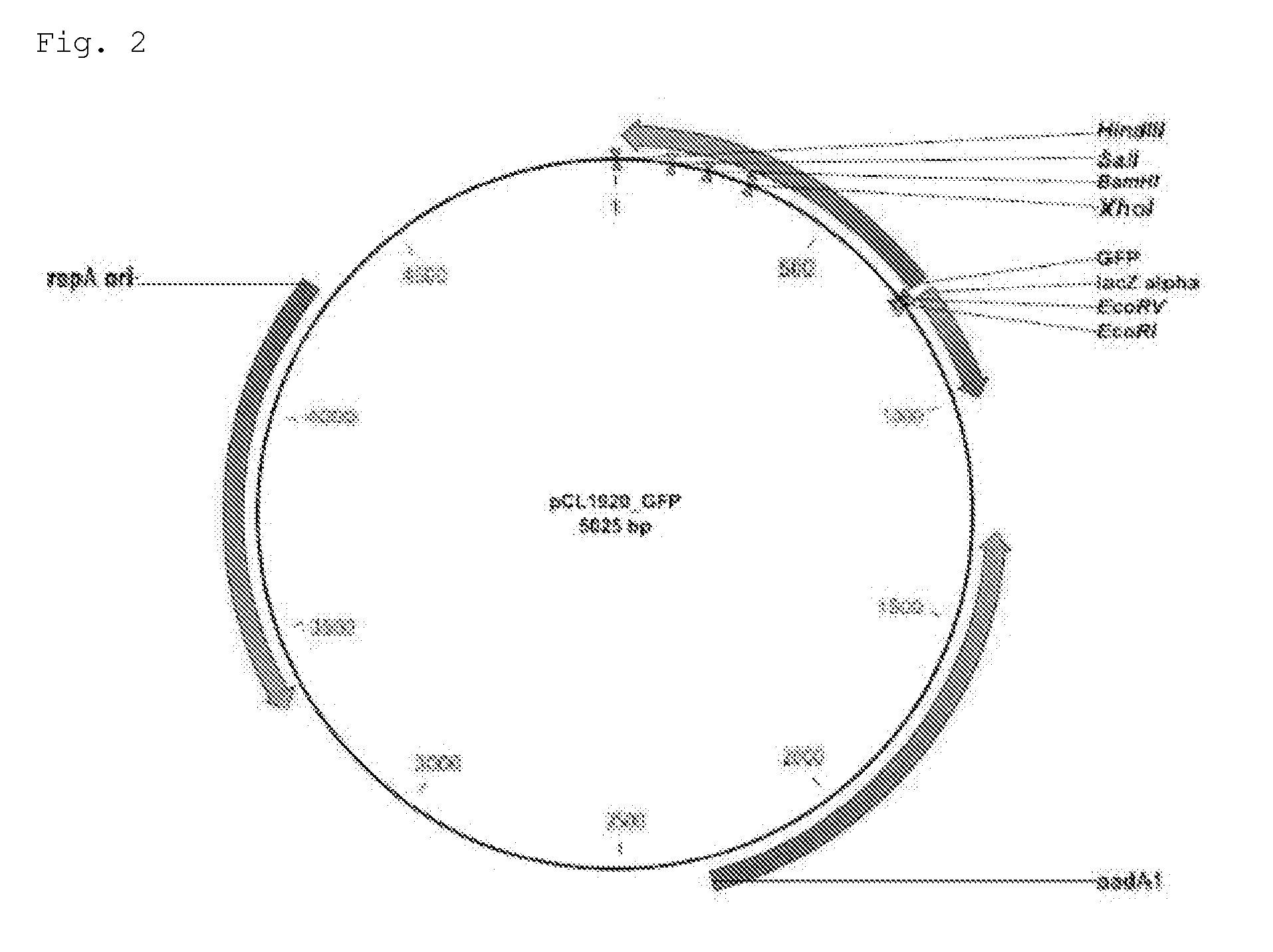Microorganism of the Genus Escherichia Having Enhanced L-Tryptophan Productivity and a Method for Producing L-Tryptophan Using the Same
a technology of escherichia and microorganisms, which is applied in the field of microorganisms of the genus escherichia having enhanced the productivity of ltryptophan and a method of producing ltryptophan using the same, can solve the problems of not reaching an increase in the production yield of tryptophan, and achieve the effect of high yield
- Summary
- Abstract
- Description
- Claims
- Application Information
AI Technical Summary
Benefits of technology
Problems solved by technology
Method used
Image
Examples
example 1
Construction of a Fusion Vector Comprising GFP and an Expression Regulatory Region from which a Leader Peptide was Removed, in Order to Release an Expression Regulation for Tryptophan Biosynthesis
[0051]As shown in FIG. 1, in order to amplify an expression regulatory region comprising a deletion of the trpL gene encoding a leader peptide (L) (the expression regulatory region is hereinafter referred to as “DtrpL”, corresponding to FIG. 1C) in an expression regulatory region of the tryptophan operon which is composed of a promoter (P), the leader peptide (L) and an attenuator (A), polymerase chain reaction (hereinafter referred to as “PCR”) was performed using the chromosomal DNA of an E. coli W3110 strain (purchased from the American Type Culture Collection (ATCC); GenBank accession number AC000091) as a template.
[0052]Specifically, a 155 bp fragment having a KpnI restriction enzyme site in the 5′ region was amplified by PCR with Pfu polymerase using primers 1 and 2 under the followin...
example 2
Measurement of Expression Level of GFP
[0056]Each of the pCL-DtrpL_GFP, pCL-Dtrp_att-GFP and pCL-Ptrp GFP vectors prepared in Example 1 was transformed into wild-type E. coli W3110 and the tryptophan-producing strain E. coli KCCM10812P, and then the intensities of GFP in the strains were measured.
[0057]The parent strain E. coli KCCM10812P (Korean Patent Registration No. 10-0792095) used in this Example is a strain derived from an E. coli variant having L-phenylalanine productivity (KFCC 10066, Korean Patent Publication No. 1985-0001232). Specifically, KCCM10812P is a recombinant E. coli strain having L-tryptophan productivity, wherein the strain has been modified to recover tryptophan auxotrophy, to inactivate the pheA, trpR, mtr and tnaAB genes, and to mutate the aroG and trpE genes.
[0058]Specifically, each of the strains was inoculated into 25 ml of M9 medium (containing 0.5% glucose+2 g / L yeast extract and further containing 0.1 g / L tyrosine and 0.1 g / L phenylalanine in the case o...
example 3
Construction of Vectors Having Tryptophan Operon (trpEDCEA) Whose Expression Regulatory Region was Replaced
[0061]Based on the results of Example 2, in order to construct an E. coli strain whose tryptophan operon genes were enhanced using a vector, a 6564 bp fragment (SEQ ID NO: 9) was amplified using the chromosomal DNA of the parent strain E. coli KCCM10812P as a template and primers 6 and 7 under the above-described PCR conditions.
[0062]The amplified DNA fragment was recovered using GeneAll® Expin™ GEL SV kit (Seoul, Korea), and then treated with the restriction enzymes EcoRV and HindIII. For cloning with the prepared DNA fragment, each of the pCL-Dtrp_att-GFP, pCL-DtrpL_GFP and pCL-Ptrp_GFP vector was treated with EcoRV and HindIII to remove the GFP region, thereby obtaining 4291 bp fragments. Each of the prepared vectors was ligated with the insert, and then introduced into E. coli DH5a by transformation, thereby constructing pCL-Dtrp_att-trpEDCBA, pCL-DtrpL_trpEDCBA and pCL-Ptr...
PUM
| Property | Measurement | Unit |
|---|---|---|
| temperature | aaaaa | aaaaa |
| temperature | aaaaa | aaaaa |
| OD | aaaaa | aaaaa |
Abstract
Description
Claims
Application Information
 Login to View More
Login to View More - R&D
- Intellectual Property
- Life Sciences
- Materials
- Tech Scout
- Unparalleled Data Quality
- Higher Quality Content
- 60% Fewer Hallucinations
Browse by: Latest US Patents, China's latest patents, Technical Efficacy Thesaurus, Application Domain, Technology Topic, Popular Technical Reports.
© 2025 PatSnap. All rights reserved.Legal|Privacy policy|Modern Slavery Act Transparency Statement|Sitemap|About US| Contact US: help@patsnap.com



